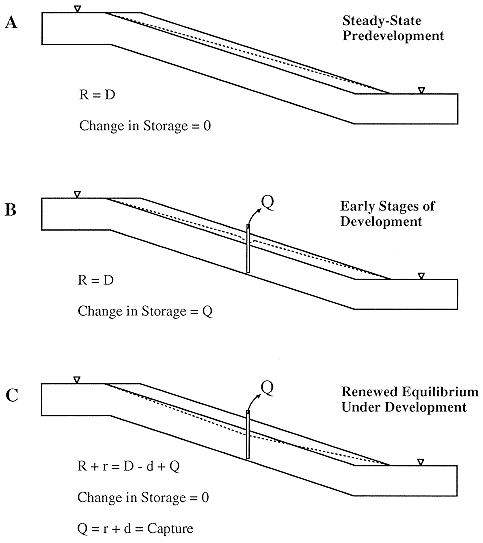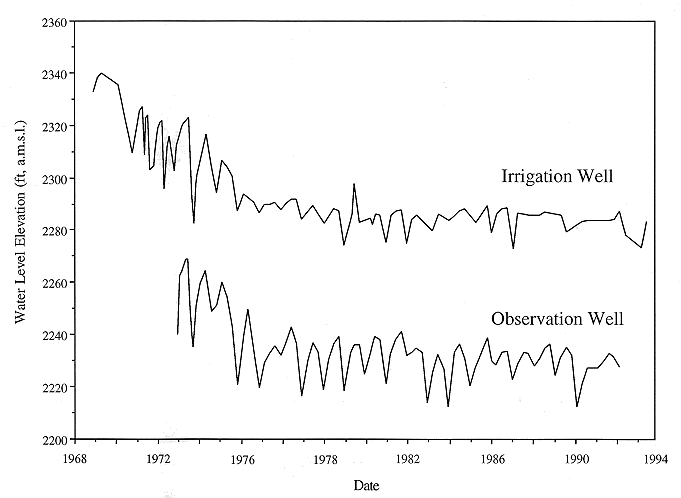
Sustainability implies the attainment of a new dynamic equilibrium under conditions of widespread development. For equilibrium to occur withdrawals from the aquifer must induce either additional recharge to the aquifer, reduced discharge from the aquifer, or both. This occurs by increasing the hydraulic gradient into the aquifer when the hydraulic head within the aquifer is decreased. These decreases will continue until changes in recharge and discharge balance withdrawals from the aquifer. The most direct evidence of this new balance is long-term stability of hydraulic heads in the aquifer. The sustained yield depends on the rate at which the hydraulic head decreases propagate through the aquifer to the recharge or discharge area. The closer the pumping centers are placed to either the recharge or discharge areas, the more likely it is that additional recharge or reduced discharge can be realized by withdrawals. The rate of propagation is a function of aquifer diffusivity (the ratio of the hydraulic conductivity and the specific storage). The higher the diffusivity, the faster the rate of propagation and the more likely it will be that pumping centers located farther away from either the recharge or the discharge areas will influence the amount of recharge and discharge.
Water budgets are useful for examining the flow of water between the various compartments within the hydrologic cycle or a ground-water flow system. Under pre-development conditions within an aquifer, there is a dynamic equilibrium between recharge and the discharge or outflow from an aquifer (Figure 1A). There is also water in storage within the pores of the aquifer framework and under these conditions, the total volume in storage remains relatively constant.
Figure 1. Changes in the water budget of a confined aquifer caused by water-resources development. The dashed line represents the trace of the potentiometric in the cross section. Under the steady-state, pre-development phase recharge (R) is balanced by discharge (D) from the aquifer with no change in storage. In the early stages of development the water produced by wells comes entirely from storage. Once the potentiometric surface has been lowered sufficiently to increase the hydraulic gradient near the recharde or discharge area, additional recharge (r) or reduced discharge (d) or both may occur, generating capture. In this later stage of development, the water produced by wells comes entirely from capture and there is no further loss of storage and a new equilibrium is created. The time required to generate significant capture depends on the diffusivity (the ratio of hydraulic conductivity to specific storage) of the aquifer.

With the introduction of pumping wells, the volume of water in each of these three catagories changes depending on the location of the pumping wells in the aquifer with respect to sources of recharge and discharge, the rates of withdrawal, and the characteristics of the aquifer. All of the water withdrawn by a pumping well in a confined aquifer comes either from storage or capture (Figure 1B). Initially, all of the water produced by the well comes from storage in the aquifer adjacent to the well. As the well continues to pump, more and more of the aquifer experiences water-level declines. Given enough time, these declines propagate to either the recharge or the discharge area, or both, producing "capture" (Figure 1C). When this happens, additional recharge enters or discharge from the aquifer system is decreased, resulting in an additional source of water added to the aquifer to balance the withdrawal. Capture is the sum of the increase in recharge and the decrease in discharge that results from the pumping. As the well continues to pump, more and more of the water produced by the well is replaced by capture. The additional recharge coming from the recharge area may result from reduced local discharge to streams in the recharge area or from another hydraulically-connnected aquifer. The generation of capture by pumping does not create any "new" water, but is merely a re-allocation of the amounts in the total hydrologic budget for a region. All other things being equal, the proportion of added recharge to or decreased discharge from the aquifer will depend on whether the well is located closer to the source of the recharge or the discharge area. Eventually, a new dynamic equilibrium occurs when the amount of water withdrawn is balanced by capture. At this point, the hydraulic heads in the aquifer approach stability at levels that are lower than they were during pre-development (Figure 2).
Figure 2. Hydrographs of a production well and an observation well in the upper Dakota aquifer of Ford County, Kansas. The wells are approximately 6 miles apart. Water-level declines during the early phase of development induce flow into the Dakota aquifer from the High Plains aquifer eventually creating a new equilibrium within the aquifer.

In the confined part of the Dakota aquifer, the effects of development will be pronounced. The distance from recharge to discharge areas is up to several hundred miles away in the Dakota in northwest Kansas. If the production wells are more than approximately 20 mi away from sources of recharge or discharge the generation of capture is unlikely within a 20 yr time frame. Even where the High Plains aquifer is present, significant amounts of additional freshwater recharge to the confined Dakota are unlikely because of the low vertical hydraulic conductivity and thickness of the overlying aquitard. Hence, all of the water withdrawn from the aquifer will come from storage. Meaningful management plansre spaced too closely together and the rates of withdrawal from the aquifer are unregulated. Computer simulations to assess the effects of pumping have demonstrated that in the confined upper Dakota aquifer, coalescing cones of depression from multiple pumping wells spaced from 1 to 4 mi apart form quickly after pumping begins. After 10 yrs, larger drawdowns than would be expected from a single pumping well are produced and a much larger area of the aquifer is affected by the withdrawals. Taking into account the heterogeneity of the Dakota, a well spacing of 20 mi in an east-west direction and 5 mi in a north-south direction is recommended to avoid mutual interference problems.r is affected by the withdrawals. Taking into account the heterogeneity of the Dakota, a well spacing of 20 mi in an east-west direction and 5 mi in a north-south direction is recommended to avoid mutual interference problems.
The steps taken to prevent depletion clearly depend on the total intensity of development. At low intensities (average spacing of major centers of withdrawal of 20 mi or more), well spacing and control of pumping rates should be adequate. At higher intensities of development, prevention of depletion is only possible by maintaining the points of withdrawal in proximity to sources of recharge or the discharge areas from the aquifer, if capture from these sources is allowed in the management scheme.
Where wells are located within the confined part of the aquifer and a few miles from the confined-unconfined boundary, the loss of storage will continue until the cone of depression due to pumping reaches a source of recharge, such as an overlying aquifer. At this point, additional recharge will be induced to enter the unconfined Dakota and the loss of water from storage will diminish and water levels in the aquifer will begin to stabilize. The time to attain this new equilibrium depends on the distance away from the source of recharge or discharge and the properties of the aquifer. In the more permeable part of the part of the aquifer, this may take up to 10 yrs or more to accomplish. Management on the basis of sustained yield may be more realistic in this part of the confined system.
However, not all of the consequences of managing these systems on the basis of sustained yield are necessarily positive. The generation of capture may result in creating saltwater intrusion problems if the points of withdrawal from the aquifer are located too closely to water quality transitions, or sources of saltwater recharge, as in the case of the Dakota aquifer in central and northwest Kansas.
From an overall management perspective capture may not be beneficial if the additional recharge moving into the confined aquifer is coming from an already overappropriated, hydraulically-connected aquifer system such as the High Plains. In the 1970s, Southwest Kansas GMD #3 declared that high capacity wells (withdrawal rates of greater than 100 acre-ft/yr) in the confined Dakota aquifer could not be located closer than five mi from the confined/unconfined boundary of the Dakota within the District. Wells pumping at lower rates can be located closer to the confined/unconfined boundary. The purpose of this regulation is to prevent induced recharge to the confined aquifer from the hydraulically connected High Plains/Dakota aquifer system by pumpage in the confined part of the Dakota.
Where the Dakota is unconfined, the effects of development will be less than in the confined part of the aquifer because pumping will be located near local recharge and discharge areas where the aquifers are more permeable. In the outcrop areas local recharge areas for the Dakota coincide with the upland areas and near the drainage divides, and local discharge zones are along the drainage network. The distance from local recharge to local discharge areas is relatively short (on the order of a few tens of miles or less). As a result, the potential for a well to generate capture and produce a new dynamic equilibrium is very much enhanced. The high probability of occurrence of sandstones with higher than average hydraulic conductivity in the outcrop belt indicates that capture can be quickly generated by pumping. This will most likely result by reduction in discharge from the aquifer to streams in central Kansas and in parts of Stanton, Morton, and Hamilton counties. The long-term hydrographs of high capacity wells tapping ground-water supplies in this part of the aquifer do not show a pattern of decline.
In much of southwestern Kansas the Dakota is hydraulically-connected to the overlying High Plains aquifer. Computer simulations demonstrate that capture is produced in the Dakota due to increase in downward leakage from the High Plains aquifer and reduced downgradient flow of water to the east. The model results also show that the High Plains-Dakota aquifer system is sensitive to the nature of the coupling between both aquifers. This suggests that the proportion of increased leakage to capture generated by pumpage also depends on this coupling. Hence, the more hydraulically connected the Dakota is to the High Plains aquifer, the more easily leakage (or flow) will transfer from one aquifer to the other in response to pumping.
Previous Page--Historic water use ||
Next Page--Proposed Management Areas
Dakota Home ||
Start of Report